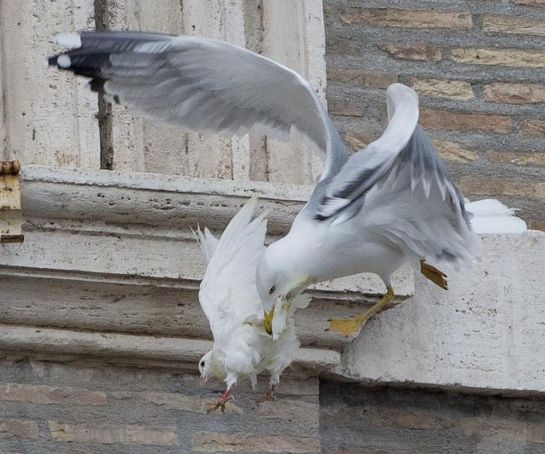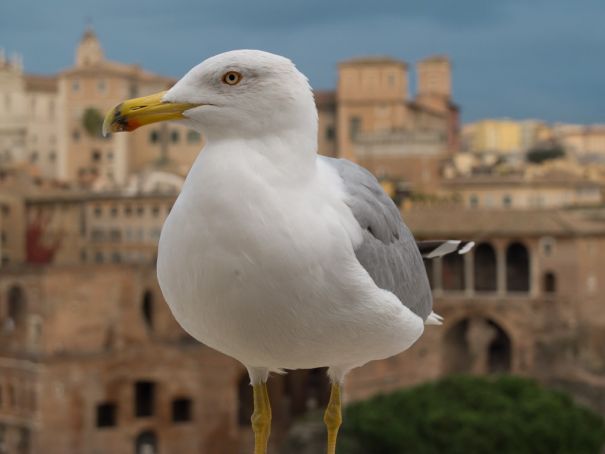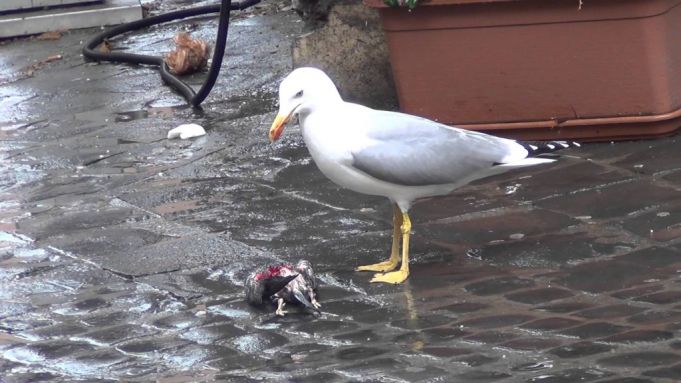Rise in seagull numbers coincides with decrease in Rome's sparrow population.
Andy Devane
St Peter's Square, 27 January 2014. As the Vatican's Sunday Angelus ceremony drew to a close, Pope Francis appealed for peace in Ukraine, where anti-government protesters had been killed. A boy and a girl standing alongside the pontiff released two white doves from the window of the Apostolic Palace, as a gesture of peace, to cheers from the tens of thousands of faithful gathered in the square below.
As the pope wished everyone his customary "buon pranzo", out of nowhere a seagull and a hooded crow swooped on the doves. The seagull pinned one dove against a wall, plucking a beakful of feathers, while the crow seized its chance when the other dove rested on a windowsill, pecking it repeatedly. Despite the onslaught, both birds appeared to escape.
The unfortunate incident was reported around the world but confirmed what many in Rome already knew for some time: that large predatory birds were muscling in on the capital in ever-increasing numbers.

To understand the phenomenon of gulls nesting in an urban, rather than their natural seaside, environment we must go back several decades. The first cases were recorded in post-war Britain but it was not until the late 1970s that gulls began nesting in towns and cities in other European countries. Older readers of Wanted in Rome will recall an era when the only time they saw gulls flying anywhere near the capital was by the sea at Ostia or Fiumicino.
Rome was the first city in Italy to welcome a couple of nesting seagulls in 1971, according to Fulvio Fraticelli, the scientific director at the Fondazione Bioparco di Roma and a leading ornithological authority in the capital. For several years the pair made their home at the zoo in Villa Borghese – some 30km from the coast – remaining an isolated case until the 1980s when the numbers of nesting gulls in Italian cities began rising slowly. Rome recorded four nesting couples in 1984. Contrast that with 30 years later when Fraticelli estimates there are now 1,500 nesting couples. Counting in the fledglings, sub-adults and temporary visitors, Fraticelli believes Rome could have up to 11,700 gulls during the peak season in late summer.
Many Romans blame the apparently sudden increase in gulls on the 2013 closure of the enormous Malagrotta rubbish dump west of Rome, which served as the capital’s refuse facility for 30 years. In reality the reasons behind the gulls' colonisation of Rome, and other European cities, are complex and manifold.
First of all, in the mid-20th century Europe's seagulls experienced a surge in numbers, leading to the birds requiring new nesting sites. A key factor in their move to urban areas is the plentiful supply of discarded food, providing rich and easy pickings for the gulls, particularly the youngsters who have no need to learn how to hunt for fish. Some gulls even know the exact opening times of their local fishmonger. Other factors include favourable ecological conditions, such as a higher than average temperature.

Until recently Rome's yellow-legged gull (larus michahellis) was treated as a subspecies of either the caspian gull or the herring gull. It is now considered a species in its own right. Found across the Mediterranean region, these birds have mackintosh-yellow legs, a grey back, white body, yellow bill with a red dot, and red-rimmed eyes. Scavengers and opportunists, they feed on discarded food, fish, rats, carrion, eggs, small animals and birds.
In Rome they can be seen at night circling the floodlit heights of the Altare della Patria monument in Piazza Venezia, a surreal and even mythical sight. The reality is less alluring – the gulls are actually feasting on bats. It is also not uncommon these days to see bloody-beaked gulls pecking pigeons to death, sometimes tearing them apart among themselves, on streets in Rome's historic centre.
Gulls can be decidedly aggressive towards humans, particularly during nesting season, between mid-March and early May. Hitchcock-style incidents of adult birds dive-bombing Rome residents – particularly those pottering around rooftop terraces near the birds' nests – are garnering increasing coverage in local media.
This behaviour is far from unique to Rome. A string of sea gull attacks in southern England made headlines during the summer. The birds allegedly killed a Chihuahua in Devon, then a Yorkshire Terrier and pet tortoise in Cornwall. The air assaults led British prime minister David Cameron to call for a "big conversation" on the issue.
Across the sea in Ireland, in the south-western county of Kerry, gulls are reportedly killing lambs in areas further and further inland from the coast. The "raucous" behaviour of Dublin seagulls caused one flustered Irish senator to exclaim that the birds had "lost the run of themselves completely" and were even “dispossessing children of their lollipops.”
There is an element of truth behind these sensational allegations. At restaurants around busy tourist areas such as Campo de' Fiori, food left on briefly-unattended tables is snatched by brazen gulls. The birds have other anti-social habits that annoy Romans too, namely “carpet-bombing” people with excrement – with supreme accuracy – and excessive noise. Residents are often kept awake at night by the booming “belly laugh” of the gulls.
People are intimidated when they open their shutters and find the large birds staring boldly back at them. Wanted in Rome recently posted a photograph on its Facebook page of a menacing-looking seagull guarding a Roman terrace. Within a couple of hours the page was inundated with similar pictures sent in from readers across the city.
The increase in Rome's gulls coincides with the decrease in its population of house sparrows, or passeri, although there is no evidence to suggest the two are connected. According to studies by Fraticelli, Rome's sparrows have been in sharp decline since the 1970s. Fraticelli notes a sudden and sustained decrease since 1989, the year that unleaded petrol was introduced. In what appears to be a bitter irony for environmentalists, the data recorded by Fraticelli reinforces the pan-European hypothesis that sparrows are suffering from the negative effect of the chemicals used to substitute the fuel's lead compounds. The general consensus is that these pollutants, when accumulated in large numbers – often by car engines left running – eliminate the tiny insects needed to feed sparrow chicks in the nest.
Despite their declining numbers, Rome's sparrows, like its gulls, are constantly adapting. At lunchtime in Piazza Farnese, an employee of the French embassy regularly entertains his colleagues and passing tourists by feeding the chirping sparrows breadcrumbs as they hover in mid-flight. Fraticellli confirms the changing behaviour of the plucky little birds: he has noted sparrows waiting for cars at motorway service stations, to eat the insects stuck on the vehicles' radiator grills, while Roman sparrows – he says – have learned the technique of dropping pine nuts to break open the edible seed inside.
The only real threat to Rome's gulls are egg-stealing crows such as the jackdaw, magpie, raven and the newest arrival from the corvus family – the hooded crow, which has colonised the river Tiber area since 1996, although there are no official population figures available yet.
But what to do about the gull influx? They are protected under Italian law, ruling out culling, and also making it difficult to control where they nest. In the past Rome has counteracted another problematic bird – the starling – by employing amplified alarm systems that mimic the birds' call of danger to move them away from the city centre. Over a few days in mid-November the city engaged five specially-trained Harris's Hawks in an experimental bid to tackle the estimated four million wintering starlings – seemingly without much success.
Far from scaring gulls, the sonic alarm system appears to annoy the birds who can react by rallying en masse against the unwelcome sound. Other methods of controlling the gulls include the laboursome relocation of nests, the sterilisation of their eggs, or insertion of dummy eggs, all of which are impractical and often ineffective.
In short, Romans should get used to the gulls, as it looks as though they are here to stay.
SIDE NOTES
How to deter gulls from “invading” your terrace:
• Never offer them food.
• Avoid feeding pets on terraces and balconies and remove all leftovers.
• Avoid leaving rubbish outside.
• Do not leave small pets outdoors on their own.
This article was published in the February 2016 edition of Wanted in Rome.






















